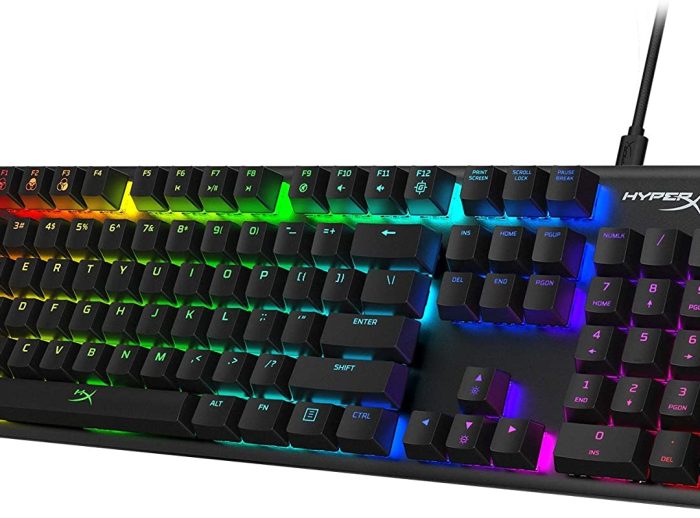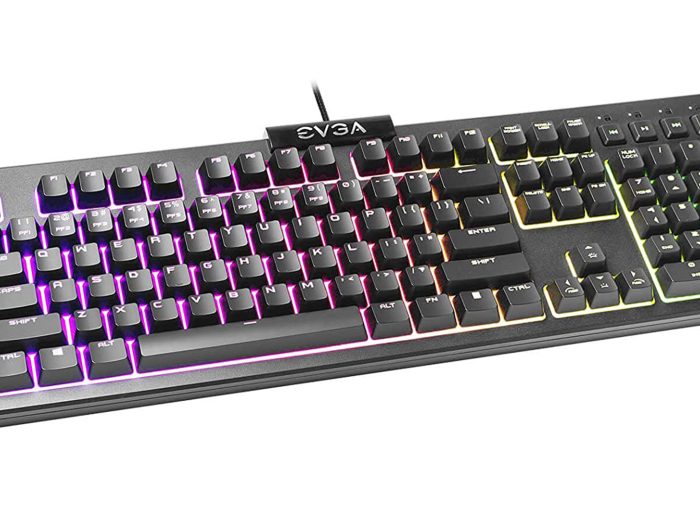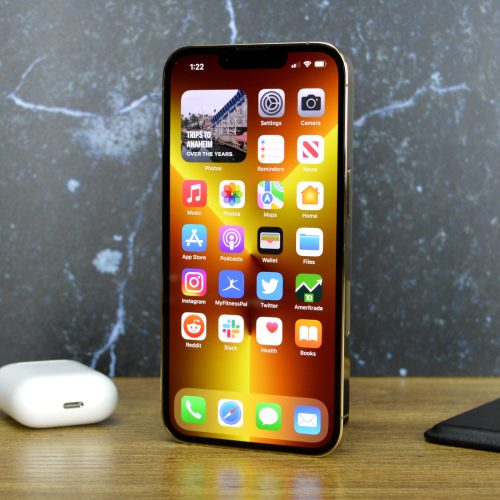Choosing the best keyboard for your setup can be tough. Not only are there a ton of options, but there is also a multitude of different keyboard types. From mechanical to ergonomic, you’re going to need to figure out what suits you best, and exactly what you need. But before you can figure out what the best keyboards are, there are a few things to keep in mind.
Ultimately, choosing a great keyboard for your setup is all about finding something that fits your budget and your needs. This list of the best keyboards should help you get started.
Best keyboard overall: Razer Pro Type Ultra
Pros
- Silent switches
- 3 modes of connection
- Over 200 hours of battery life
Cons
- May get dirty easily
- No color options for backlighting
- Price is high for limited features
While technically a mechanical keyboard, the Razer Pro Type Ultra takes the spot of our best overall keyboard for a lot of reasons. First, the response time that comes from being using mechanical switches makes it perfect for a myriad of roles. Typists, programmers, and even everyday users will fall in love with how great typing on it is.
The nice thing about this keyboard, too, is that the Yellow switches Razer users combined with sound-dampening foam, make it an exceptionally quiet typer. That means you don’t have to worry about disturbing the fine folks in the cubicle three aisles over from you. It also means you get the exceptional response time of a mechanical keyboard without all that headache.
Razer has also packed this bad boy with three different connection options, including Bluetooth, wired, and 2.4Ghz. With so many ways to connect, the Razer Pro Type Ultra pairs nicely with just about any device out there. You can also pair up to four devices without re-pairing. There are also other great wireless keyboards out there.
The only real downside to this particular keyboard is the white backlight. If you’re a fan of Razer’s standard RGB options, then you’ll probably be disappointed to learn you can’t change the color here. But, if you want a professional-looking keyboard that types great and doesn’t give you (or your coworkers) headaches, then the Pro Type Ultra is a clear winner.
Best gaming keyboard: HyperX Alloy Origins
Pros
- Multi-level adjustment
- Compact design
- Fantastic RGB lighting
Cons
- No media keys
- Software may be difficult to use
HyperX has become a well-known name in the gaming space for a good reason. Not only does it make some of the best gaming headsets around, but it also makes great keyboards. The HyperX Alloy Origin is one of the best gaming keyboards you’ll find because of its compact design.
The Alloy Origins also comes with three levels of height adjustment on the back, which means you can make typing even more comfortable by setting it to a height that fits your needs. What really makes it stand out above the myriad of other options, though, is its strict focus on gaming. There are no frills here. This means no media keys of extra macros. While that might be disappointing for some, the HyperX Alloy Origins is exceptionally good at what it does offer.
The switches here are clicky, though not too loud like some mechanical keyboards. They aren’t as quiet as those found in offerings like the Razer Pro Type Ultra, but if you’re gaming you probably aren’t worried about that so much. The included RGB backlighting is also extremely customizable, which is another reason gamers will fall in love with this keyboard. Sadly, the software that HyperX uses to customize the RGB is less than intuitive, so it might take some getting used to.
Best mechanical keyboard: Das Keyboard 4 Professional
Pros
- Loaded with features
- Heavy but compact design
Cons
- No backlights
- Limited Switch support
When it comes to mechanical keyboards, there are a lot of great brands out there. You’ve probably seen names like Razer, SteelSeries, but the best manufacturers don’t stop there. Over the years, Das Keyboards has continued to grow in recognition, and that isn’t by chance. The company continues to offer high-quality products for solid prices and the Das Keyboard 4 Professional is no different.
You won’t find some of the frills and features found on other mechanical options here, but Das doesn’t need backlights to make a fantastic keyboard. The switches here are extremely clicky and responsive, and the amount of features baked into it are exceptional.
Furthermore, the compact design means it will fit in with just about any size setup. That compactness doesn’t come at a cost in build quality, either. The metal frame of the keyboard feels heavy and welcoming when you settle up against it. Likewise, the included keys feel great against your fingers and should be comfortable for long hours of use.
You won’t get to choose between a ton of different switches with this keyboard, though, so if you really want customization, we recommend checking out some other great mechanical options from companies like Ducky and SteelSeries.
Best budget keyboard: EVGA Z12
Pros
- High-end features
- Inexpensive
Cons
- Keys feel a little cheap
- Latency isn’t great
There’s nothing wrong with a good budget keyboard. In fact, I spent several years using a cheap 10 dollar one I’d found at Walmart without much worry. But, if you want to spend less and still get a solid keyboard, then the EVGA Z12 is a great option.
This one isn’t going to offer the same build quality that you might expect from more expensive options, but at under $100, there isn’t too much to complain about here. The price is good, the number of features that the keyboard touts are great, and it feels decent enough to type on. Like most budget keyboards, the keys won’t feel as great as more expensive variants. But, again, that’s just something that comes with these types of peripherals.
Some have also reported that the keyboard suffers from a few latency issues. This could impact its usage in things like gaming, but for everyday typing, that shouldn’t be cause for concern. If you need a solid keyboard that isn’t going to break the bank, this could be a great option.
Best keyboard for Macs: Apple Magic Keyboard with Touch ID
Pros
- Compact design
- Pairs easily
- Touch ID
Cons
- May get dirty in white
- Not cheap
Apple’s Magic Keyboard is one of the best we’ve ever used, hands down. The keys feel great, the response time is fantastic, and it’s extremely compact. If you’ve ever used an Apple computer, or even a MacBook, then running the Magic Keyboard as a peripheral shouldn’t be a new idea. If it is, we recommend picking one up and trying it out for yourself.
There’s a lot to love here. First, there are multiple options to choose from, including one that comes with TouchID built-in. It also works seamlessly across multiple devices thanks to technology in Apple’s operating systems. This makes it easy to work on multiple screens without having to pair it back and forth or purchase third-party software.
The design here follows the status quo Apple has become known for over the years. While it’s nothing new, it feels welcoming, especially for Mac users who are already used to the keyboards that Apple utilizes. If you go looking, you’ll find that there are several third-party options out there for the Mac. There’s nothing wrong with them, of course. But, at the end of the day, none come close.
What to look for in a keyboard
There are a number of things to keep in mind when buying a new keyboard. First, think about what type of keyboard you want. Do you want a super-clicky and responsive mechanical keyboard or are you looking for something quieter? Where will you use this keyboard? While some keyboards can be great for response time, the switches they use might be too loud for office workplaces where other people have to listen to you type. You’ll also want to account for what kind of space you have to work in, as larger keyboards will make typing at smaller setups more of a hassle.
Here’s a deeper dive.
Connectivity
Perhaps the first thing to consider is whether you want a wired keyboard or a wireless one. There are advantages and disadvantages to both. Wired keyboards don’t have to be charged and theoretically offer lower latency. Wireless keyboards make for a cleaner desk look but have to be charged. These days, the latency on wireless keyboards is pretty low — and we don’t think most people will notice latency on wireless keyboards, except for the most experienced of PC gamers. That’s especially true of wireless keyboards that connect through a 2.4GHz dongle, instead of Bluetooth.
Size

There are a few considerations to make around the size of a keyboard. Perhaps the most basic decision to make is whether you want a number pad or not. The number pad has become less and less common with laptops, but some still prefer having it.
There are standardized keyboard sizes though, normally expressed in a percentage. A full-size keyboard with a number pad is a 100% keyboard. One step down is 96%, which eliminates some of the spacing between some of the sets of keys, but keeps the number pad. Then there’s the 75% size, which eliminates the number pad, but keeps some of the extra keys, like the page up and down keys. A 65% keyboard eliminates those extra keys. Smaller sizes eliminate even more keys. You’ll have to decide for yourself what size is best for you. For more information about keyboard sizes, check out this guide.
Switches

The type of switch on your keyboard is important to consider too. There are a few different main types of switches to consider. Capacitive switch keyboards are considered to be non-mechanical, because of the fact that they don’t physically complete a circuit when pressed. These keyboards often last longer, but they’re also more expensive, and don’t necessarily offer the tactile feel you’ll get on mechanical keyboards.
Mechanical keyboards have all different kinds of switches. Rubber dome switches are common on cheap keyboards and involve the key pushing down on a rubber dome that pushes down on a matrix, completing the circuit. Membrane keyboards have a membrane that stretches across the whole keyboard, with a pattern that’s printed and completes the circuit when a key is pressed. Metal contact and foam contact keys are getting less common, but involve a metal strip being pressed down to complete the circuit.
Extra controls
Some keyboards offer extra controls that can make specific workflows a little easier. For example, some keyboards might have a button that lets you switch between different connections. Others might have specific editing controls. And others might have programmable buttons for gaming.
Design
Of course, it’s also worth considering the overall design of the keyboard. Some keyboards offer RGB lighting, while others prioritize a sleek office look. Design may not impact your day-to-day use as much, but you still probably want something that looks good.
Price
Last but not least, you’ll want to think about the price of the keyboard. Better keyboards, usually, are more expensive — but that doesn’t mean that you can’t find a good deal.













